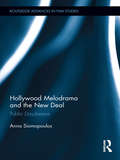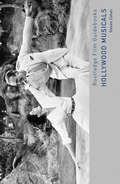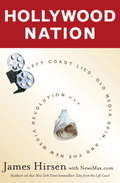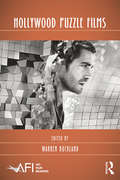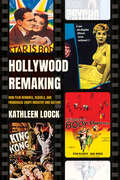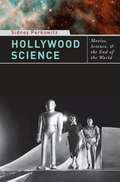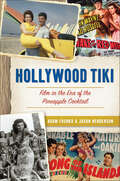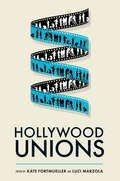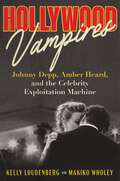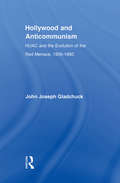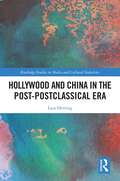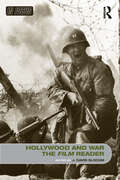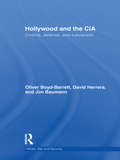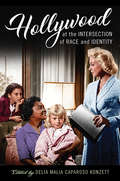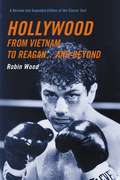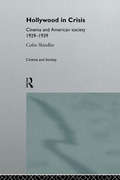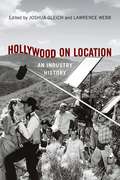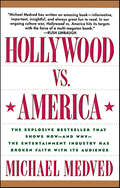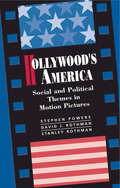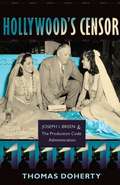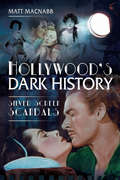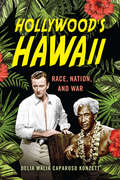- Table View
- List View
Hollywood Melodrama and the New Deal: Public Daydreams (Routledge Advances in Film Studies)
by Anna SiomopoulosWhile many critics have analyzed the influence of the FDR administration on Hollywood films of the era, most of these studies have focused either on New Deal imagery or on studio interactions with the federal government. Neither type of study explores the relationship between film and the ideological principles underlying the New Deal. This book argues that the most important connections between the New Deal and Hollywood melodrama lie neither in the New Deal iconography of these films, nor in the politics of any one studio executive. Rather, the New Deal figures prominently in Hollywood melodramas of the Depression era because these films engage the political ideas underlying welfare state policies—ideas that extended the reach of government into the private realm. As the author shows, Hollywood melodramas interrogated New Deal principles of liberal empathy—consumer citizenship, the refeudalization of the state, and minimal economic redistribution—only to support welfare-state ideology in the end.
Hollywood Musicals (Routledge Film Guidebooks)
by Steven CohanHollywood Musicals offers an insightful account of a genre that was once a mainstay of twentieth-century film production and continues to draw audiences today. What is a film musical? How do musicals work, formally and culturally? Why have they endured since the introduction of sound in the late 1920s? What makes them more than glittery surfaces or escapist fare? In answering such questions, this guidebook by Steven Cohan takes new and familiar viewers on a tour of Hollywood musicals. Chapters discuss definitions of the genre, its long history, different modes of analyzing it, the great stars of the classic era, and auteur directors. Highlights include extended discussions of such celebrated musicals from the studio era as The Love Parade, Top Hat, Holiday Inn, Stormy Weather, The Gang’s All Here, Meet Me in St. Louis, Cover Girl, Mother Wore Tights, Singin’ in the Rain, Gentlemen Prefer Blondes, The Band Wagon, Seven Brides for Seven Brothers, and Jailhouse Rock as well as later films such as Cabaret, All that Jazz, Beauty and the Beast, and La La Land. Cohan brings in numerous other examples that amplify and extend to the present day his claims about the musical, its generic coherence and flexibility, its long and distinguished history, its special appeal, and its cultural significance. Clear and accessible, this guide provides students of film and culture with a succinct but substantial overview that provides both analysis and intersectional context to one of Hollywood’s most beloved genres.
Hollywood Nation
by James HirsenFrom the bestselling author ofTales from the Left Coast. Now entering Hollywood Nation, where fact blurs with fiction, virtue with vice Now more than ever, stars like Michael Moore, Sean Penn, and Susan Sarandon are acting as self-appointed celebrity pundits, blurring the lines between entertainment and news to force their views onto the rest of the country. With their politically charged films, distorted documentaries, and skewed docudramas, they’re trying to set the agenda with little regard for the truth. Even worse, many so-called journalists are doing the same thing, dangerously mixing information and entertainment in an attempt to ratchet up ratings—and to inject their own views into the news. InHollywood Nation,New York Timesbestselling author and media critic James Hirsen reveals how the New Media are leading the counterattack against the relentless liberal assault from East Coast newsrooms and Left Coast studios. Through his extensive research and exclusive interviews with news and entertainment iconoclasts—including Bill O’Reilly, Mel Gibson, and Ann Coulter—Hirsen shows how liberals are losing their stranglehold on political and cultural debates. With a new chapter full of news about the ongoing Hollywoodization of America, Hirsen’s smart and compellingHollywood Nationgives us ammunition for the battle to reclaim our country and our culture.
Hollywood Planet: Global Media and the Competitive Advantage of Narrative Transparency (Routledge Communication Series)
by Scott Robert OlsonThe popularity of American television programs and feature films in the international marketplace is widely recognized but scarcely understood. Existing studies have not sufficiently explained the global power of the American media nor its actual effects. In this volume, Scott Robert Olson tackles the issue head on, establishing his thesis that the United States' competitive advantage in the creation and global distribution of popular taste is due to a unique mix of cultural conditions that are conducive to the creation of "transparent" texts--narratives whose inherent polysemy encourage diverse populations to read them as though they are indigenous. Olson posits that these narratives have meaning to so many different cultures because they allow viewers in those cultures to project their own values, archetypes, and tropes into the movie or television program in a way that texts imported from other cultures do not, thus enabling the import to function as though it were an indigenous product. As an innovative volume combining postcolonial and postmodern theory with global management strategic theory, Hollywood Planet is one of the first studies that attempts to account theoretically for numerous recent ethnographic studies that suggest different interpretations of television programs and film by a variety of international audiences. Relevant to studies in media theory and other areas of the communication discipline, as well as anthropology, sociology, and related fields, Hollywood Planet contains a powerful and original argument to explain the dominance of American media in the global entertainment market.
Hollywood Puzzle Films (AFI Film Readers)
by Warren BucklandFrom Inception to The Lake House, moviegoers are increasingly flocking to narratologically complex puzzle films. These puzzle movies borrow techniques—like fragmented spatio-temporal reality, time loops, unstable characters with split identities or unreliable narrators—more commonly attributed to art cinema and independent films. The essays in Hollywood Puzzle Films examine the appropriation of puzzle film techniques by contemporary Hollywood dramas and blockbusters through questions of narrative, time, and altered realities. Analyzing movies like Source Code, The Butterfly Effect, Donnie Darko, Déjà Vu, and adaptations of Philip K. Dick, contributors explore the implications of Hollywood's new movie mind games.
Hollywood Remaking: How Film Remakes, Sequels, and Franchises Shape Industry and Culture
by Kathleen LoockFrom the inception of cinema to today’s franchise era, remaking has always been a motor of ongoing film production. Hollywood Remaking challenges the categorical dismissal in film criticism of remakes, sequels, and franchises by probing what these formats really do when they revisit familiar stories. Kathleen Loock argues that movies from Hollywood’s large-scale system of remaking use serial repetition and variation to constantly negotiate past and present, explore stability and change, and actively shape how the film industry, cinema, and audiences imagine themselves. Far from a simple profit-making exercise, remaking is an inherently dynamic practice situated between the film industry’s economic logic and the cultural imagination. Although remaking developed as a business practice in the United States, this book shows that it also shapes cinematic aesthetics and cultural debates, fosters film-historical knowledge, and promotes feelings of generational belonging among audiences.
Hollywood Science: Movies, Science, and the End of the World (Acs Symposium Ser. #1139)
by Sidney PerkowitzWhether depicting humans battling aliens or a brave geologist saving lives as a volcano erupts, science-fiction films are an exciting visual and sensuous introduction to the workings of science and technology. These films explore a range of complex topics in vivid and accessible ways, from space travel and laser technology to genetic engineering, global warming, and the consequences of nuclear weaponry. Though actual scientific lab work might not be as exciting, science fiction is an engaging yet powerful way for a wide audience to explore some of the most pressing issues and ideas of our time.In this book, a scientist and dedicated film enthusiast discusses the portrayal of science in more than one hundred films, including science fiction, scientific biographies, and documentaries. Beginning with early films like Voyage to the Moon and Metropolis and concluding with more recent offerings like The Matrix, War of the Worlds, A Beautiful Mind, and An Inconvenient Truth, Sidney Perkowitz questions how much faith we can put into Hollywood's depiction of scientists and their work; how accurately these films capture scientific fact and theory; whether cataclysms like our collision with a comet can actually happen; and to what extent these films influence public opinion about science and the future. Movies, especially science-fiction films, temporarily remove viewers from the world as they know it and show them the world as it might be, providing special perspective on human nature and society. Yet "Hollywood science" can be erroneous, distorting fact for dramatic effect and stereotyping scientists as remote and nerdy, evil, or noble, doing little to improve the relationship between science and society. Bringing together history, scientific theory, and humorous observation, Hollywood Science features dozens of film stills and a list of the all-time best and worst science-fiction movies. Just as this genre appeals to all types of viewers, this book will resonate with anyone who has been inspired by science-fiction films and would like to learn how fantasy compares to fact.
Hollywood Tiki: Film in the Era of the Pineapple Cocktail
by Adam FoshkoIsland Escapes, South Seas Adventures, and Musical Surf Parties of Midcentury CinemaTiki Culture arose as the defining expression of American pop culture during World War II and its influence continued through the 1960s. The essence of Tiki featured heavily in films of the era, depicting palm-tree and cocktail-laden escapes that captivated audiences nationwide. Films like South Pacific and The Man in the Gray Flannel Suit were a hodgepodge of jungle imagery and World War II Pacific theater memories. A fascination with the new State of Hawaii was reflected in Elvis's Blue Hawaii, while balmy youth flicks like Beach Blanket Bingo and Gidget showcased surf, sun and fun.Join authors Jason Henderson and Adam Foshko as they explore films about the experiences of war filtered through the tropical splendor that defined an era.
Hollywood Unions
by Barbara Hall Helen Warner Miranda J. Banks Paul Monticone Maya Montañez Smukler Adrienne L. McLean Luci Marzola Katie Bird Kate Fortmueller Dawn Fratini Erin HillHollywood Unions is a unique collection that tells the stories of the unions and guilds that have organized motion picture and television labor: IATSE, the DGA, SAG-AFTRA, and the WGA. The Hollywood unions represent a wide swath of the workers making media: from directors and stars to grips and makeup artists. People today know some of these organizations from their glitzy annual awards celebrations, but the unions’ actual importance is in bargaining with the Association of Motion Picture and Television Producers (AMPTP) on behalf of 331,000 workers in the motion picture and television industry. The Hollywood unions are not neutral institutions but rather have long histories of jurisdictional battles, competitions with rival unions, and industry-altering strikes. They have supported the industry’s workers through the Great Depression, World War II, the McCarthy era, the collapse of the studio system, the rise of television, runaway production, fights for gender parity, the digital revolution, and a global pandemic. The history of these unions has contributed to making media work sustainable in the long term and helped shape the conditions and production cultures of Hollywood.
Hollywood Vampires: Johnny Depp, Amber Heard, and the Celebrity Exploitation Machine
by Kelly Loudenberg Makiko WholeyAn explosive new book on the infamous trial Depp v. Heard, Hollywood Vampires paints an intimate picture of what was really going on behind the viral headlines between Johnny Depp and Amber Heard, with never-before-told stories from their inner circle.Celebrity romances have always captured the public’s imagination, playing out like soap operas seized upon by fans and tabloids alike. By the same token, high-profile trials can take over the mainstream media cycle, with both news pundits and the public picking over every detail to predict outcomes and cast their own judgements. Enter the union, dissolution, and hostile legal battle between Johnny Depp and Amber Heard—where these dual obsessions collided, creating a chaotic moment of true cultural fixation.Hollywood Vampires offers an inside account of one of the most controversial and consequential celebrity scandals of the internet era. Fueled by viral clips, reaction videos, and endless online debates, the trial became more than a legal battle. It became a public spectacle, dividing audiences worldwide.Kelly Loudenberg and Makiko Wholey were journalists on the ground for the Depp v Heard trial. Having closely followed Johnny, Amber, and their camps, they spent the years leading up to and following the trial interviewing the couple’s closest allies as well as their managers, lawyers, agents, business associates, publicists, assistants, and personal staff. The result is a page-turning Hollywood epic full of revealing details that tell a wider tale about the celebrity-industrial complex, modern fandom, inflammatory culture wars, and contemporary feminism. Turning the lens around, Hollywood Vampires questions how the celebrity exploitation machine, strengthened by the forces of social media and legacy media alike, blurs the lines between fact and fiction, comedy and horror. It forces us to ask ourselves why we take celebrity culture so seriously in the first place—and who wins and who loses when Hollywood becomes the vehicle for our own personal and political causes.
Hollywood and Anticommunism: HUAC and the Evolution of the Red Menace, 1935-1950 (Studies in American Popular History and Culture)
by John J. GladchukThis work concentrates on tracing the evolution of the so-called "red menace" phenomenon as a means of demonstrating the correlation between growing American paranoia and the success of the anticommunist campaign (1935-1955). The House Committee on Un-American Activities 1947 investigation of Hollywood, the nation's most visible industry, served a critical role in conjuring up anti-red hysteria and fanning the flames of virulent anticommunism. Using conveniently unjust tactics, the Committee "painted" targeted Hollywood personalities red and established the infamous blacklist - certified proof in the minds of many that "subversives" were indeed conspiring from within. A failed attempt on behalf of the "Hollywood Ten" to demonstrate the Committee’s undemocratic nature allowed HUAC to forge ahead with its investigation and establish the anticommunist foundation upon which Joseph McCarthy would construct his campaign. Hollywood and Anticommunism stands as an important contribution to McCarthy-era literature and should appeal to all interested in the early Cold War and the impact that unwarranted hysteria has had and continues to have on the growth and development of the nation.
Hollywood and China in the Post-postclassical Era (Routledge Studies in Media and Cultural Industries)
by Lara HerringThis book examines the contemporary relationship between Hollywood and China as case studies that help to define a new era in Hollywood film industry, style, and economics, which is termed the ‘post‑postclassical’ period.Centred around a case study of Legendary Entertainment, the analysis shows how the studio adopted and adapted its global strategies in order to gain access to and favour within the Chinese film market, and how issues of censorship and financial performance affected the choices they made. Demonstrating Legendary’s identity as a ‘post‑postclassical’ studio and examining how this plays into its China‑strategy, this book explores how this particular case and the necessary analysis of wider political economic relations offer a periodisation of the contemporary Hollywood‑China relationship.This book will interest students and scholars of media and film studies, as well as academics whose research interests include global cinema, Hollywood, Chinese cinema, transnational cinema, and film industry studies.
Hollywood and Hitler, 1933-1939 (Film and Culture Series)
by Thomas DohertyBetween 1933 and 1939, representations of the Nazis and the full meaning of Nazism came slowly to Hollywood, growing more ominous and distinct only as the decade wore on. Recapturing what ordinary Americans saw on the screen during the emerging Nazi threat, Thomas Doherty reclaims forgotten films, such as Hitler's Reign of Terror (1934), a pioneering anti-Nazi docudrama by Cornelius Vanderbilt Jr.; I Was a Captive of Nazi Germany (1936), a sensational true tale of "a Hollywood girl in Naziland!"; and Professor Mamlock (1938), an anti-Nazi film made by German refugees living in the Soviet Union. Doherty also recounts how the disproportionately Jewish backgrounds of the executives of the studios and the workers on the payroll shaded reactions to what was never simply a business decision. As Europe hurtled toward war, a proxy battle waged in Hollywood over how to conduct business with the Nazis, how to cover Hitler and his victims in the newsreels, and whether to address or ignore Nazism in Hollywood feature films. Should Hollywood lie low, or stand tall and sound the alarm?Doherty's history features a cast of charismatic personalities: Carl Laemmle, the German Jewish founder of Universal Pictures, whose production of All Quiet on the Western Front (1930) enraged the nascent Nazi movement; Georg Gyssling, the Nazi consul in Los Angeles, who read the Hollywood trade press as avidly as any studio mogul; Vittorio Mussolini, son of the fascist dictator and aspiring motion picture impresario; Leni Riefenstahl, the Valkyrie goddess of the Third Reich who came to America to peddle distribution rights for Olympia (1938); screenwriters Donald Ogden Stewart and Dorothy Parker, founders of the Hollywood Anti-Nazi League; and Harry and Jack Warner of Warner Bros., who yoked anti-Nazism to patriotic Americanism and finally broke the embargo against anti-Nazi cinema with Confessions of a Nazi Spy (1939).
Hollywood and War, The Film Reader (In Focus: Routledge Film Readers Ser.)
by J. David SlocumDiscussing such classic films as Sergeant York, Air Force, and All Quiet on the Western Front, as well as more modern blockbusters like Apocalypse Now and Saving Private Ryan, this outstanding volume focuses on Hollywood and its production of war films.Topics covered include:the early formation of war cinemathe apotheosis of the Hollywood war filmthe ascendancy of ambivalenceHollywood and the war since Vietnamwar as a way of seeing. For any student of film studies or American cultural studies, this is a valuable companion.
Hollywood and the CIA: Cinema, Defense and Subversion (Media, War and Security)
by Oliver Boyd Barrett David Herrera James A. BaumannThis book investigates representations of the Central Intelligence Agency (CIA) in Hollywood films, and the synergies between Hollywood product, U.S. military/defense interests and U.S. foreign policy. As probably the best known of the many different intelligence agencies of the US, the CIA is an exceptionally well known national and international icon or even "brand," one that exercises a powerful influence on the imagination of people throughout the world as well as on the creative minds of filmmakers. The book examines films sampled from five decades - the 1960s, 1970s, 1980s, 1990s and 2000s - and explores four main issues: the relative prominence of the CIA; the extent to which these films appeared to be overtly political; the degree to which they were favorable or unfavorable to the CIA; and their relative attitude to the "business" of intelligence. A final chapter considers the question: do these Hollywood texts appear to function ideologically to "normalize" the CIA? If so, might this suggest the further hypothesis that many CIA movies assist audiences with reconciling two sometimes fundamental opposites: often gruesome covert CIA activity for questionable goals and at enormous expense, on the one hand, and the values and procedures of democratic society, on the other. This interdisciplinary book will be of much interest to students of the CIA/Intelligence Studies, media and film studies, US politics and IR/Security Studies in general.
Hollywood at the Intersection of Race and Identity
by Ellen C. Scott Delia Malia Konzett Jonna Eagle Louise Wallenberg Dean Itsuji Saranillio Charlene Regester Ryan Jay Friedman Ruth Mayer Alice Maurice Matthias Konzett Chris Cagle Graham Cassano Priscilla Peña Ovalle Ernesto R Acevedo-Muñoz Mary Beltrán Jun OkadaHollywood at the Intersection of Race and Identity explores the ways Hollywood represents race, gender, class, and nationality at the intersection of aesthetics and ideology and its productive tensions. This collection of essays asks to what degree can a close critical analysis of films, that is, reading them against their own ideological grain, reveal contradictions and tensions in Hollywood’s task of erecting normative cultural standards? How do some films perhaps knowingly undermine their inherent ideology by opening a field of conflicting and competing intersecting identities? The challenge set out in this volume is to revisit well-known films in search for a narrative not exclusively constituted by the Hollywood formula and to answer the questions: What lies beyond the frame? What elements contradict a film’s sustained illusion of a normative world? Where do films betray their own ideology and most importantly what intersectional spaces of identity do they reveal or conceal?
Hollywood from Vietnam to Reagan . . . and Beyond
by Robin WoodThis classic of film criticism, long considered invaluable for its eloquent study of a problematic period in film history, is now substantially updated and revised by the author to include chapters beyond the Reagan era and into the twenty-first century. For the new edition, Robin Wood has written a substantial new preface that explores the interesting double context within which the book can be read-that in which it was written and that in which we find ourselves today. Among the other additions to this new edition are a celebration of modern "screwball" comedies like My Best Friend's Wedding, and an analysis of '90s American and Canadian teen movies in the vein of American Pie, Can't Hardly Wait, and Rollercoaster. Also included are a chapter on Hollywood today that looks at David Fincher and Jim Jarmusch (among others) and an illuminating essay on Day of the Dead.
Hollywood in Crisis: Cinema and American Society 1929-1939 (Cinema and Society)
by Colin SchindlerFirst published in 1996. Routledge is an imprint of Taylor & Francis, an informa company.
Hollywood on Location: An Industry History
by Julian Stringer Daniel Steinhart Sheri Chinen Biesen Jennifer Lynn Peterson Noelle GriffisLocation shooting has always been a vital counterpart to soundstage production, and at times, the primary form of Hollywood filmmaking. But until now, the industrial and artistic development of this production practice has been scattered across the margins of larger American film histories. Hollywood on Location is the first comprehensive history of location shooting in the American film industry, showing how this mode of filmmaking changed Hollywood business practices, production strategies, and visual style from the silent era to the present. The contributors explore how location filmmaking supplemented and later, supplanted production on the studio lots. Drawing on archival research and in-depth case studies, the seven contributors show how location shooting expanded the geography of American film production, from city streets and rural landscapes to far-flung territories overseas, invoking a new set of creative, financial, technical, and logistical challenges. Whereas studio filmmaking sought to recreate nature, location shooting sought to master it, finding new production values and production economies that reshaped Hollywood’s modus operandi.
Hollywood vs. America: The Explosive Bestseller that Shows How—and Why—the Entertainment Industry has Broken Faith with Its Audience
by Michael MedvedWhy does our popular culture seem so consistently hostile to the values that most Americans hold dear? Why does the entertainment industry attack religion, glorify brutality, undermine the family, and deride patriotism? In this explosive book, one of the nation's best known film critics examines how Hollywood has broken faith with its public, creating movies, television, and popular music that exacerbate every serious social problem we face, from teenage pregnancies to violence in the streets. Michael Medved powerfully argues that the entertainment business follows its own dark obsessions, rather than giving the public what it wants: In fact, the audience for feature films and network television has demonstrated its profound disillusionment in recent years, with disastrous consequences for many entertainment companies. Meanwhile, overwhelming numbers of our fellow citizens complain about the wretched quality of our popular culture--describing the offerings of the mass media as the worst ever. Medved asserts that Hollywood ignores--and assaults--the values of ordinary American families, pursuing a self-destructive and alienated ideological agenda that is harmful to the nation at large and to the industry's own interests. In hard-hitting chapters on "The Attack on Religion," "The Addiction to Violence," "Promoting Promiscuity," "The Infatuation with Foul Language," "Kids Know Best," "Motivations for Madness," and other subjects, Medved outlines the underlying themes that turn up again and again in our popular culture. He also offers conclusive evidence of the frightening real-world impact of these messages on our society and our children. Finally, Medved shows where and how Hollywood took a disastrous wrong turn toward its current crisis, and he outlines promising efforts both in and outside the industry to restore a measure of sanity and restraint to our media of mass entertainment.Sure to elicit strong response, whether it takes the form of cheers of support or howls of enraged dissent, Hollywood vs. America confronts head-on one of the most significant issues of our times.
Hollywood's America: Social And Political Themes In Motion Pictures
by Stephen P PowersAmerican motion pictures still dominate the world market with an impact that is difficult to measure. Their role in American culture has been a powerful one since the 1930s and is a hallmark of our culture today. Though much has been written about the film industry, there has been very little systematic attention paid to the ideology of its creative elite. How does the outlook of that elite impact on the portrayals of America that appear on the screen? How do their views interact with the demands of the market and the structure of the industry to determine the product that is seen by mass audiences? Hollywood's America is a marvellously rich and careful discussion of these questions. It combines a meticulous systematic content analysis of fifty years of top-grossing films with a history of the changing structure of the industry. To that mixture it adds an in-depth survey of Hollywood's creative elite, comparing them to other leadership groups. The result is a balanced discussion of unique breadth and depth on a subject of national importance.Placing the film industry in the context of American society as a whole, the authors point out that Hollywood's creative leadership impacts the larger society even as it is influenced by that society. The creators of films cannot remove themselves too far from the values of the audiences that they serve. However, the fact that films are made by a relatively small number of people, who, as the authors demonstrate, tend to share a common outlook, means that, over time, motion pictures have had an undeniable impact on the beliefs, lifestyles, and action of Americans.This study contributes to the debate over the role and influence of those who create and distribute the products of mass culture in the United States.The book also contains a devastating critique of the poststructuralist theories that currently dominate academic film criticism, demonstrating how they fail in their attempt to explain the political significance of motion pictures.
Hollywood's Censor: Joseph I. Breen and the Production Code Administration
by Thomas DohertyThe story of the man who made Hollywood moral.
Hollywood's Censor: Joseph I. Breen and the Production Code Administration
by Thomas DohertyFrom 1934 to 1954 Joseph I. Breen, a media-savvy Victorian Irishman, reigned over the Production Code Administration, the Hollywood office tasked with censoring the American screen. Though little known outside the ranks of the studio system, this former journalist and public relations agent was one of the most powerful men in the motion picture industry. As enforcer of the puritanical Production Code, Breen dictated "final cut" over more movies than anyone in the history of American cinema. His editorial decisions profoundly influenced the images and values projected by Hollywood during the Great Depression, World War II, and the Cold War. Cultural historian Thomas Doherty tells the absorbing story of Breen's ascent to power and the widespread effects of his reign. Breen vetted story lines, blue-penciled dialogue, and excised footage (a process that came to be known as "Breening") to fit the demands of his strict moral framework. Empowered by industry insiders and millions of like-minded Catholics who supported his missionary zeal, Breen strove to protect innocent souls from the temptations beckoning from the motion picture screen. There were few elements of cinematic production beyond Breen's reach-he oversaw the editing of A-list feature films, low-budget B movies, short subjects, previews of coming attractions, and even cartoons. Populated by a colorful cast of characters, including Catholic priests, Jewish moguls, visionary auteurs, hardnosed journalists, and bluenose agitators, Doherty's insightful, behind-the-scenes portrait brings a tumultuous era-and an individual both feared and admired-to vivid life.
Hollywood's Dark History: Silver Screen Scandals
by Matt MacNabbThirteen sensational tales of sex, lies, violence, and murder from the early decades of Hollywood.The dawning of the nineteenth century brought with it a new era for entertainment. Vaudeville was the preferred form of entertainment, until the popularization of the silent film. This new medium proved to be a draw for many of the stars of the Vaudevillian stage and soon they migrated to the exciting possibilities that the movies had to offer. Audiences were instantly captivated by the stars of the silent screen. The early days of Hollywood were full of glamour and a newfound decadence. The stars in these films were catapulted to fame and fortune and the spotlight of the public eye. But the real people behind the glamour were far different from the characters that audiences knew and loved, and much like Hollywood today, the lives of the stars were often full of scandal and debauchery.This book examines the forgotten scandals of Hollywood’s early years, featuring silent and silver screen stars like Jean Harlow, Mae West, Mary Pickford, Charlie Chaplin, and Errol Flynn. Don’t let the romanticized black and white world of yesterday fool you. Their stories are rife with sex, drugs, and murder.
Hollywood's Hawaii: Race, Nation, and War
by Delia Malia KonzettWhether presented as exotic fantasy, a strategic location during World War II, or a site combining postwar leisure with military culture, Hawaii and the South Pacific figure prominently in the U.S. national imagination. Hollywood’s Hawaii is the first full-length study of the film industry’s intense engagement with the Pacific region from 1898 to the present. Delia Malia Caparoso Konzett highlights films that mirror the cultural and political climate of the country over more than a century—from the era of U.S. imperialism on through Jim Crow racial segregation, the attack on Pearl Harbor and WWII, the civil rights movement, the contemporary articulation of consumer and leisure culture, as well as the buildup of the modern military industrial complex. Focusing on important cultural questions pertaining to race, nationhood, and war, Konzett offers a unique view of Hollywood film history produced about the national periphery for mainland U.S. audiences. Hollywood’s Hawaii presents a history of cinema that examines Hawaii and the Pacific and its representations in film in the context of colonialism, war, Orientalism, occupation, military buildup, and entertainment.
